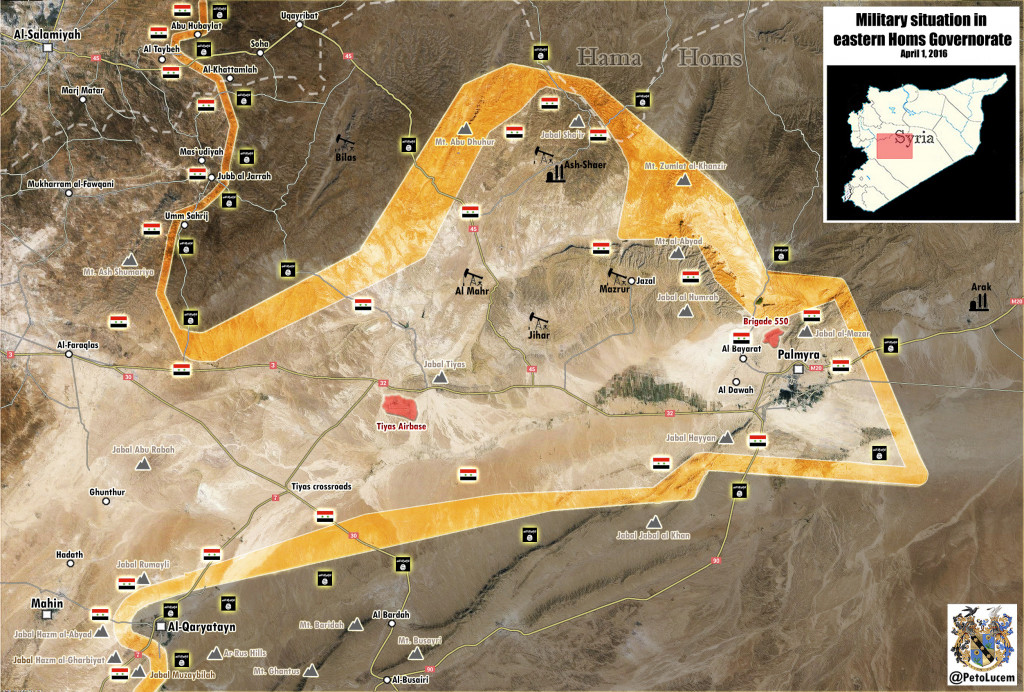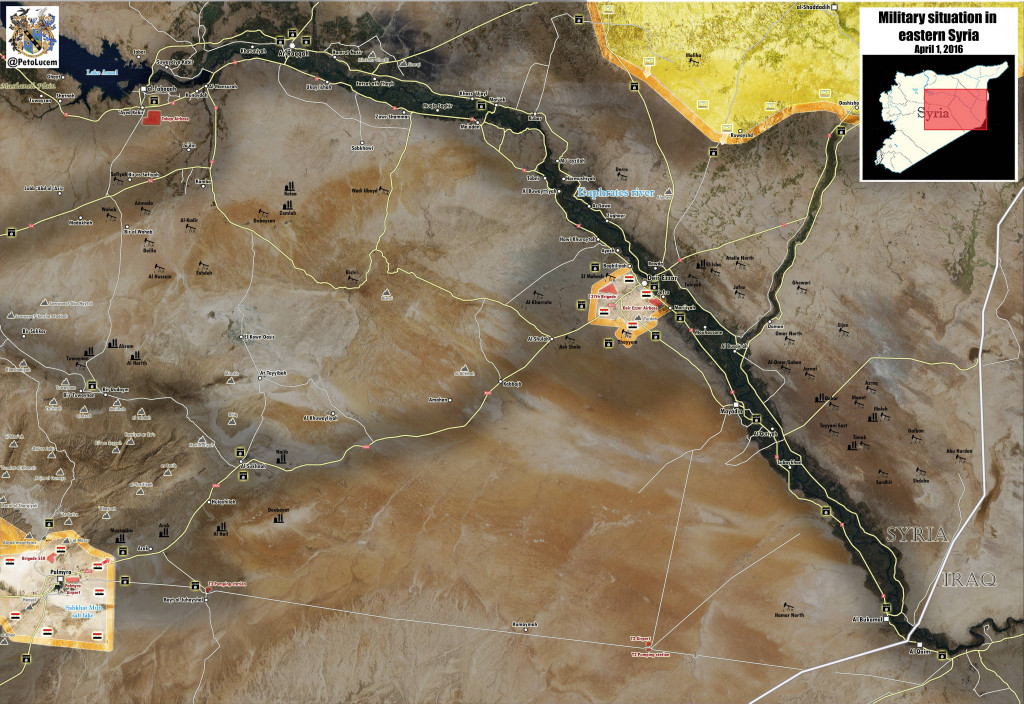Written by Peto Lucem exclusively for SouthFront
The ancient city of Palmyra, which was first documented in the early second millennium BC, is located in Syria’s present-day Homs Governorate. It was captured by the so called “Islamic State” (ISIS) in May 2015 when ISIS was expanding its control over central Syria. Days after Palmyra’s fall on May 21, 2015 ISIS captured the towns of Al-Furqlus (30 kilometers SE of the Homs city), Qaryatayn and a majority of the nearby Shaer mountains. Due to these gains, ISIS became able to:
- put pressure on the strategic town of Al-Salamiyah, located 20 kilometers SE of Hama
- threaten the provincial capitals of Homs and Hama
- threaten the strategic Damascus-Aleppo (M5) highway
Taking into account these facts, the Syrian government invested significant resources to recapture Palmyra. On March 9, the Syrian Arab Army’s 67th Brigade and the 134th Armoured Brigade of the 18th Tank Division, supported by Syria’s Special Forces (Tiger Forces, Desert Hawk Brigade) and Syrian Marines, launched the long anticipated counteroffensive aimed at retaking Palmyra.
The town was finally liberated after intense artillery and aerial bombardment and heavy clashes on March 27. This strategic victory was described by mainstream media as the Islamic State’s “biggest loss ever”. ISIS reportedly suffered between 400 and 550 casualties during the 18 days of the loyalist forces’ offensive. A decisive factor of the success was the support provided by the Russian Aerospace Forces.
The liberation of Palmyra opens a few strategic opportunities:
Deir Ezzor Governatore and Raqqa Governorate play an important role in ISIS’ oil smuggling business due to a high number of oil fields and refineries located there. The liberation of these governatores will allow the SAA to cut off ISIS’ financial revenues dramatically.
All eyes rest now on the besieged Government enclave at Deir Ezzor, approximately 120 kilometers NE of Palmyra. Breaking the several months old ISIS siege of Deir Ezzor Governorate’s capital is a tempting opportunity, but such are not always the most rewarding and enduring ones. One year ago, the important town of Sukhna – the gateway to Deir Ezzor – fell swiftly to ISIS and closed the pocket in May 2015. As previously mentioned, ISIS also captured many more areas to the west. It seems the lesson had to be learned that this 120 kilometers long road between Palmyra and Deir Ezzor is very difficult to hold – especially while so many ISIS staging areas remain nearby in the North and the South.
This is why the SAA has to consolidate the gains in Homs Governatore before an advance on Deir Ezzor. First of all, the army should focus on securing areas near Palmyra: especially the town of Qaryatayn and the Qaryatayn-Palmyra road. Preparations to liberation Qartanatain are already underway and this town is expected to fall in the next few days.
As soon as Qaryatayn is under control, the army should liberate the vast mountainous area north of Palmyra. Such an action is important, because this is a formidable defensive position by which the SAA can protect Palmyra’s northern flank. Mount al-Mar’eh, Mount Khashabiyah or Jabal al ‘Aşāb could serve as excellent artillery observation points and would allow the monitoring of enemy movements up to the Tabqa airbase, Maskaneh plain and even the Khanaser-Aleppo road.
The SAA should also consider pushing back ISIS militants in Eastern Hama Governorate. Over the last few days the army conducted military operations in these areas and recaptured Tal Hikmat hilltop and Tal Tabarah Al-Deibah east of the Al-Salamiyah city. Securing East Hama would also take a lot of pressure from the vital Hama-Aleppo road. As long as ISIS pockets east of Al-Salamiyah exist, this supply route remains vulnerable.
Then the SAA could expand its control on Al Sukhnah and especially on Bayt al Juhayshal and the nearby T3 pumping station to set the ground for an advance through the Al-Sukhnah-Palmyra road. If this is done, the SAA may consider an advance even further SE to the T2 pumping station. If the SAA holds this area and redeploy air assets to the abandoned T2 helicopter airfield, it will be able to monitor ISIS movements along the Iraqi border SE of Palmyra. This step would efficiently block any attempt by Islamic State forces to launch counter attacks on Palmyra or the road leading to Deir Ezzor from the south.
Simultaneously to this southeastern push, the SAA should focus on Tabaqa Airbase by launching attacks from at least 2 (preferably 3) different axis.
The Tabaqa attack operation could be launched from
- Khanaser area (west)
- Al-Sukhnah (southwest)
- Maskaneh plain (northwest )
It must be mentioned that an advance from Maskaneh plain is not realistic at the moment, since the SAA would have to secure Deir Hafir and Maskaneh towns beforehand. Taking these strongholds would afford a considerable amount of resources and time. On the other hand, the Maskaneh plain’s liberation would effectively secure the Khanaser – Aleppo supply route once and for all, since it would cut off ISIS forces operating in the desert region east of the highway.
Following the recapture of Tabaqa Airbase the SAA would be able to prevent any ISIS movement along the Euphrates western river bank from Tabaqa to Deir Ezzor and would enable the SAA to block counterattacks coming from ISIS staging areas on the opposite riverbank of the Euphrates. Tabqa Airbase’s capture would also increase the pressure on ar Raqqa city – Islamic State’s most important stronghold in Syria.
All these steps would effectively secure the road to Deir Ezzor and would grant a permanent supply route into the city. Reports indicate that the besieged elements of the Republican Guard and the 137th Mechanized Brigade at Deitr Ezzor are still capable of conducting limited counteroffensives in and near the Governorate’s capital and thus still possess a high combat value. Taking this into consideration, it would be a wise decision to clear the previously mentioned areas prior to focusing on breaking the siege, especially considering that ISIS is now under severe pressure from the Syrian Democratic Forces (SDF) which are currently advancing on Deir Ezzor. Yesterday SDF forces liberated Ruwayshd, the nearby train station and the Maliha Oil Field. Forward SDF forces are now deployed only 50 kilometers to the cities north-west. An ISIS takeover of the Deir Ezzor pocket is thus more unlikely now than ever.
Time will tell if loyalist forces decide for the more complex and time consuming – but sustainable – strategy or if the Syrian Government and its allies seek to reach Deir Ezzor sooner with the risk of repeating the costly and fruitless mistakes of the past.








Excellent analysis! And a great read!
Peto, once more a superb article, congratulations, excellent analysis and concur with you on each one.
There is one difference from past efforts. That is the availability of Russian anti-armor helicopters along with substantial Syrian and Russian aircover and much improved SAA tactics and hardware. Combined, all these factors may be sufficent to negate the dangers of a quick drive to Deir ez Zor. Maintaining the momentum would also increase the stress on the already depleted ISIS resources and pressure them psychologically. However, this is just idle speculation from me. We will soon see what the Syrian/Russian/Hezbollah forces have in mind.
There’s also the fact that the SDF reaching there would increase their legitimacy as not just a kurdish force, but a multi-ethnic force and would push them to take Raqqa as well, and then strengthen the factors pushing for the federalization of the country. Therefore taking control of the major population centres of all the provinces in the shortest time may be a more important concern right now than a secure and more permanent gain, as that can be achieved later after a more set ceasefire comes into place
Correction: IS never captured Al-Furqlus town … the nearest they came was when they seized the EBLA gas treatment plant some 6 km East of it in mid July 2014 before being driven back ~10 days later.